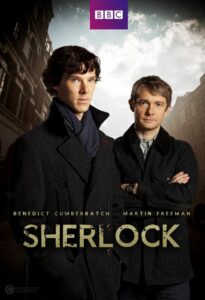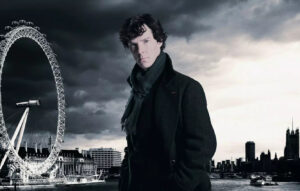“Sherlock” – London Puzzle [Series Review]

Title: “Sherlock” (TV series)
Date of Release: 2010 – 2017
Cast: Benedict Cumberbatch, Martin Freeman, Mark Gatiss, Una Stubbs, Andrew Scott, Lara Pulver
Produced by the BBC, “Sherlock” is a real treat for fans of ambitious series. The risky idea of transferring the story of the legendary detective from the prose of Arthur Conan Doyle to modern realities, in my opinion, worked brilliantly. For we can embark on an exciting tour of the nooks and crannies of present-day London and solve criminal mysteries together with the genius. And the most fascinating mystery turns out to be not so much the intricate world of sophisticated crimes, but Sherlock himself and his unparalleled mind.
“Sherlock” and its serial adaptation
The character of Sherlock Holmes from Arthur Conan Doyle’s short stories has permanently entered pop culture. Everyone associates the extraordinarily astute London detective who, together with his faithful friend and also assistant, Dr. John Watson, solves the most intricate criminal cases. A refreshing take on the tale set in Victorian England was presented in 2009 by Guy Ritchie, casting Robert Downey and Jude Law in the leading roles. Holmes here deviates from the stereotypical image of the distinguished Briton, instead exposing his physical prowess and the repulsive disposition that accompanies his outstanding abilities. The creators here present a clearly modernized psychology of the character, enriched by the study of the essence of brilliant personalities, very often burdened with disorders in the sphere of interpersonal relations. The screenwriters of the BBC series followed a similar path: Steven Moffat and Mark Gatiss, additionally moving the reality of the whole story to contemporary London.
The role of the brilliant detective was bravuraly played by Benedict Cumberbatch, and Dr. Watson was brilliantly played by Martin Freeman. Both actors were recognized for their performances with Emmy awards, among others. Despite the modernization of the time and place of the action, the characters of Sherlock and his professional partner have retained their distinctive features. Thus, the detective often wears a deerstalker-type hat, a long coat and smokes a pipe. He also does not shy away from drug stimulants, which he claims lighten his mind. Watson, on the other hand, is a war veteran and doctor; unlike Holmes, who shuns women, he seeks the woman of his life, and eventually marries and moves away from his friend. Inherent in the atmosphere of the whole story is also the cozy London apartment of the supercilious Mrs. Hudson (Una Stubbs) on Baker Street. For fans of Sherlock’s adventures attached to the traditional version, the creators have also prepared a special episode – “The Phantom Bride” – set in 19th century London.

The series “Sherlock” and the mysteries of London
I enjoyed watching the series “Sherlock”, and the formula of successive episodes allowed me to get close to the characters and enjoy the London atmosphere. The British capital, with its inherent characteristic cabs, red-brick houses and interiors with slightly old-fashioned decor, was beautifully presented here. The ritual of drinking aromatic tea, steaming from porcelain cups, could not be missed either. London rises here almost to the status of a separate hero of history, is the quintessence of Britishness and peculiarities that distinguish it from other European cities. It can be said that the British capital is as unique as the main character of the series. And this is not an empty platitude: it is no coincidence that the production opens with an episode with a theme of London cab drivers. It perfectly introduces the viewer to the labyrinthine urban space, for it is worth noting that, according to University College research, cab drivers in this metropolis have a more developed system of neural connections in the brain thanks to their excellent orientation in the extremely complex topography.
I must admit that the most delicious bites in this production seemed to me not so much the criminal puzzles themselves, but just everything that played out in between the cases. Therefore, I constantly felt a certain unsatisfaction, because I would have liked to sit longer over tea with Sherlock, ask Mrs. Hudson about her interesting past, or learn more about Watson’s subsequent partners. Despite the sophisticated plot ideas piling up levels of intrigue and crime in front of the viewer, the biggest mystery in “Sherlock” remains the protagonist himself: an unfathomable genius with clear emotional disturbances. This almost walking pure intelligence, with traits consistent with the autism spectrum, fascinates and captures the attention of the viewer.
“Sherlock” – comic book, computer and memory palace
In “Sherlock” a very important role is played by all digital communications, appearing in computers, laptops and smartphones, which are not only an inherent aspect of modernity, but also act as a narrative bracket. Indeed, each of these attributes comments on the story through text: SMS or blog, introducing additional motifs that are not explicitly visible on the screen. What’s more, Sherlock’s famous process of deduction is depicted in a manner analogous to the action of passwords typed into an Internet search engine. When the detective examines the body of a victim, for example, close-ups of his corpse are accompanied by subtitles reflecting the result of his investigation. In this way, the series also alludes to the poetics of comic books, in which the image is accompanied by balloons with text.

Therefore, the viewer’s most intriguing activity remains tracing the intricate paths of Sherlock’s labyrinthine mind. The series uses modern psychological knowledge and research on the workings of human memory. Furthermore, we have the opportunity to observe various visualizations of the workings of Sherlock’s brain and his talented enemies. The image of the famous memory palace locating specific information based on associations with places, the library where various books and documents are stored (Magnusson) or the image of digital files in the computer are not only metaphors explaining the operation of a well-trained mind, but also real mnemonic techniques used in concentration training. A similar function is played by visualizations related to the structure of the psyche – the conscious and subconscious, where various experiences and traumas are stored. These, in turn, are used in cognitive-behavioral therapies that allow patients to deal with the problems that plague them.
What is fascinating here, then, is the construction of a hybrid space, i.e. one in which what is “real” coexists on equal terms with what is digital (SMS, emails) and with the world that is a product of human imagination. For regardless of the type of medium – reality always remains an emanation of the human interior, and the most modern tools only reflect our depth. In this way, “Sherlock” brilliantly on many levels builds a bridge between its Victorian-era literary prototype and the modern – post-modern audience.
